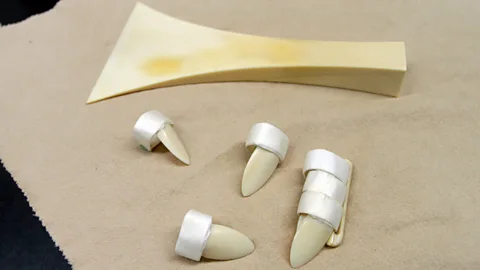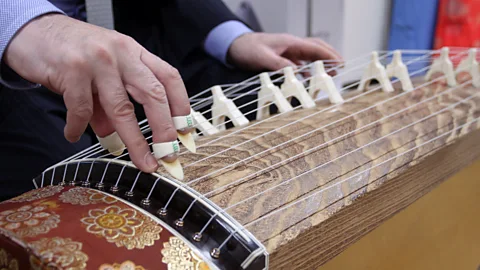The survival of Japan’s music rests on artificial ivory
 Alamy
AlamyThe loss of natural ivory could threaten traditional Japanese instruments. Now some musicians are now teaming up with scientists to find a replacement
Shoin Hagioka thumps the base of his koto, marking time as his fingers dance across the long, wooden instrument’s 13 strings. Sitting across from Hagioka, a student at Tokyo University of the Arts, Leo Konno, gingerly joins in, raising his voice to meet his professor’s and plucking the strings of his own koto.
By studying Japanese music, Konno is helping to keep a centuries-old tradition alive. But the quality of his playing may never match that of his instructor’s – not for lack of talent or effort, but for lack of ivory.
To produce the best sound possible, a koto requires 13 sturdy ivory bridges and three delicate ivory plectrums that resemble long fingernails. Shamisen, a three-stringed, guitar-like instrument also requires ivory for the bridge and the bachi, a fan-shaped plectrum about the size of a reporter’s notebook. “Everyone playing koto or shamisen at a high level is using ivory,” Hagioka says. “Without ivory, I’m concerned that it will be very difficult to continue Japanese traditional music.”
In 1989, many nations – including the US and members of the European Community and many African and Asian countries – voted to ban international ivory trade – and for good reason. In the preceding decade, elephant populations across Africa were halved thanks to poaching for their tusks, which were in high demand in Japan. For a few years, the ban seemed to work, but in the mid-2000s, poaching once again picked up. From 2007 to 2014, savannah elephant populations fell by 30%, while forest elephants – Africa’s smaller species, whose ivory is most valued in Japan – fared even worse, declining by 62% from 2002 to 2013.
You might also enjoy:
China is the primary culprit behind the most recent poaching crisis, and in January 2018, hoping to help put an end to the killing, China banned its domestic ivory trade. This left Japan as the world’s largest legal market for ivory. As evidence of illegal dealings among Japan’s ivory traders builds, the country faces increasing pressure to follow China’s lead and shut its market.
The impacts of such a ban would not be evenly distributed among Japanese ivory users. Hankos, or traditional name seals, account for about 80% of Japan’s ivory consumption – but they can be easily substituted with any number of other materials, including crystal, metal, plastic or wood. Musical instruments are a very different case. Players insist that ivory produces a superior sound quality compared to plastic, wood or ceramic, and that it is gentler on the body during long performances. Without it, Japanese traditional music would suffer.
 Rachel Nuwer
Rachel NuwerMany of Japan’s leading traditional musicians and scholars believe, however, that there could be another way. Aided by materials scientists and conservationists, they have come together in the hopes of creating a synthetic ivory that spares elephants’ lives, yet sacrifices none of the qualities that makes ivory so desirable. “I want to find a substitute so we can stand with the world while also keeping traditional Japanese music alive,” says Masataro Imafuji, a shamisen player and a Living National Treasure, or a person designated by the government as having attained the highest mastery possible of a Japanese art.
“For me, it’s very important to keep harmony and peace with the environment and the world,” Imafuji says. “That’s the spirit of Japanese traditional music and the core ideal of Japanese culture itself.”
Evolving traditions
Now 83 years old, Imafuji looks back fondly on his childhood spent surrounded by music. Both of his parents performed professionally and his mother also taught students at home. “Even when I was little, I knew the music by ear and could sing it,” Imafuji says. He decided to follow in his parents’ footsteps – not only because he loved music, but also because he wanted to keep traditions alive.
As Imafuji perfected his playing, he also became versed in the history of his craft. Ivory, he learned, was not always a component of shamisen and koto. Both instruments came from China, with koto arriving in Japan around AD700 and shamisen appearing in the 16th Century Eiroku period. Musicians at first used turtle shell, wood or buffalo horn for the parts now made of ivory, but as the instruments’ popularity grew, they began to change. The bodies of shamisen became bigger, and their snakeskin coverings were replaced with cat and dog skin. A distinctly Japanese style of music began to emerge. “As per usual in Japan, shamisen and koto were arranged to fit Japanese culture,” Imafuji says.
 Getty
GettyThe instruments’ popularity grew during the Edo period (from 1603 to 1868), a time when people developed “a taste for beauty”, as Imafuji says. Fashion, literature and the arts took off, as did kabuki – a type of theatre accompanied by live music, now designated by Unesco as an intangible cultural heritage of Japan. As years passed and performance halls expanded to accommodate larger audiences, musicians needed a bolder sound. Through trial and error, they found that with ivory their music could reach even the far corners of the room. Ivory also proved more comfortable to play with, Imafuji says, and it had “a rarity that added to the spectacular, glamorous scene performers wanted to create on stage”.
Ivory remains most musicians’ material of choice today, not only for its superior tone quality but also for the ability it gives them to sustain performances without discomfort. “If I play long with a plastic bachi, I may injure my shoulder because that material is very inflexible,” says Yosihiko Tokumaru, a professor emeritus of Japanese traditional music at Ochanomizu University in Tokyo. “Ivory protects performers’ bodies.”
The music industry’s need for ivory is unlikely to disappear any time soon. Although koto and shamisen are no longer as popular as they once were, a growing number of young musicians, including Konno, have begun taking them up. Some are interested in the old Edo-era songs, while others are using the instruments for reimagined roles, including for jazz. Although the number of new recruits still does not equal those who are dropping out, in these young players older musicians see hope for the future.
Although Japan continues to allow domestic ivory trade, the ban on international trade in 1989 creates many difficulties for these musicians. For one, those who wish to bring their shamisen or koto abroad face customs hurdles and even seizure of their instruments. “Even if an ivory bachi was made 200 years ago, foreign governments may confiscate it,” Tokumaru says.
Creating an internationally-recognised ivory passport program for certified instruments would solve this problem, Tokumaru believes. In January, Japan’s Agency for Cultural Affairs responded favourably to a letter he sent proposing such a scheme. For now, though, musicians traveling abroad must bring plastic or wooden substitutes, he says, and “foreigners who want to enjoy the authentic sound of Japanese traditional music have to come to Japan”.
 Rachel Nuwer
Rachel NuwerWorries are building, though, even among musicians who do not perform overseas. If Japan decides to follow much of the rest of the world by closing its domestic ivory market, musical instruments would likely make up the most complicated and controversial part of the new law, says Masayuki Sakamoto, an environmental lawyer and the executive director of the Japan Tiger and Elephant Fund, a non-profit organization in Tokyo advocating for an ivory ban. If Japan does close its market, Sakamoto continues, it should ensure that certain instruments are given a pass, as the US and UK have done. “We don’t intend to kill their culture,” he says. “If the musician community demonstrates an understanding of elephant conservation and makes a commitment to phase out ivory in the future, Japan should allow some narrow exemptions for them.”
But even if Japan does not ban ivory, the material’s days are still numbered. No one knows how many uncarved tusks are stockpiled in the country, but unless new ones are smuggled in illegally, ivory dealers will run out eventually. As supplies dwindle, musicians predict that the already pricey material will become even more unaffordable, excluding all but the wealthiest players years before ivory stores actually run out.
Change, in other words, is inevitable. But this is not necessarily a bad thing, Imafuji points out, because Japanese music has never been static. “The instruments themselves have been changing over time, as have the sounds that are appreciated as beautiful,” he says. Cat and dog skins traditionally used to make shamisen, for example, are starting to be replaced with kangaroo skins and a type of artificial hide, both of which hold promise for producing high-quality sound but are more in line with current thinking in terms of animal rights. Ivory could follow a similar path, he says – if only an adequate substitute were available.
Art meets science
Many of Imafuji’s musician colleagues are well aware of the problems surrounding ivory. But as non-scientists, they lack the expertise needed to manufacture a solution themselves. Luckily, they are not the only ones considering the future of ivory in Japan.
 Rachel Nuwer
Rachel NuwerTomoaki Nishihara, a conservation fellow at the Wildlife Conservation Society, spent the last 30 years in the Republic of the Congo and Gabon, witnessing the forest elephant poaching crisis first hand. He learned that his own country was to blame for much of the killing throughout the 1980s and that forest elephant ivory remains Japan’s material of choice. As Nishihara dug deeper, he realized that of all the uses for ivory in Japan – including as name seals, art works and accessories – musicians were the only ones who truly had an essential need for the material. He felt compelled to act.
“We have to stop blaming ivory users in Japan, including traditional musicians, only from an emotional point of view,” he says. “We need to find a more scientific way to explain the elephant crisis, and to bring concrete solutions for the future of traditional culture.”
Nishihara reached out to the Hogaku Journal, a magazine focusing on traditional Japanese music, and through them made connections with some of Japan’s most influential players, including Imafuji. He explained to the musicians the impacts poaching was having in the field, including the ecosystem-wide effects of removing elephants.
“I learned that destroying elephants whose ivory is used in instruments means destroying not only the animals themselves, but the environment at large,” Imafuji says. “I really do not want to use the name of culture to destroy what is precious to the environment and to ourselves.”
To broaden the dialogue, in 2014, Nishihara organized a seminar that brought together around 50 musicians and scholars to discuss ivory’s future in Japan. “At that first seminar, I listened to people from many standpoints and occupations,” says Haruko Komoda, a professor of Japanese music history at Musashino Academia Musicae in Tokyo. “I realized that although we all had different perspectives on ivory, we were united in thinking that it is an issue.”
Nishihara also reached out to materials scientists, imploring them to use Japan’s “world-class technology”, as he says, to help find a solution. Chikara Ohtsuki, a professor at Nagoya University who specializes in artificial bones, answered that call. “For an artificial substitute, it is very hard to compete with natural materials like ivory, I know,” Ohtsuki told Kyodo News in 2014. “However, I will try to come as close to it as I can.”
 Getty
GettyIvory is an incredible material, able to withstand the force exerted by a 12,000lb (5443kg) animal while fighting, digging or knocking down trees. Tusks, however, are nothing more than very large teeth, primarily composed of hydroxyapatite, a calcium phosphate compound. But despite ivory’s similarity to bone and human teeth, it possesses unique properties that present challenges for recreating it in the lab. Because ivory grows constantly throughout an elephant’s life, it contains two distinct structures, one at the micro-scale and the other at the nano-scale. It is also riddled with tiny pores, about one-tenth the size of cells. These characteristics give the material its strength – but they are also the reason ivory is so difficult to replicate.
In 2016, Ohtsuki managed to synthesize a small ivory-like block. But without any designated funding for the project, he has struggled to scale up production to something big enough to be useful for musicians. Nishihara approached a number of Japanese companies, hoping one of them would be interested in taking on the project to boost their social impact portfolio, but none agreed, citing financial constraints. It also seems unlikely that the Japanese government will step up. Representatives of various ministries that Nishihara and his colleagues have approached insist that they either do not have the funds or that the issue is outside their purview.
Though exasperated, the team is unwilling to give up. “We’re a really small group, and maybe our interests are easy to ignore,” Komoda says. “But by actually addressing this and finding a solution, maybe we could serve as a model for other communities around the world facing similar conflicts between culture and [the need to protect] endangered species.”
Ohtsuki’s efforts may be stalled, but others are progressing. Fritz Vollrath, a biologist at the University of Oxford, is conducting trials with a silk cellulose and hydroxyapatite-based ivory replacement. Vollrath and his colleagues in China believe the material could eventually be used to make artworks, piano keys, billiard balls and biomedical implants. The insights gained from studying ivory could perhaps even also be used to invent new car bumpers and other objects that would benefit from the material’s unique mix of energy absorption, flexibility and toughness.
There’s no reason, Vollrath says, that the ivory replacement his team is creating could not also be used for Japanese traditional instruments. “For us, this is really about trying to understand the material’s qualities and then seeing, from a commercial point of view, whether we can make it,” he says. “Obviously, the goal from there is to put it out for people to use.”
Vollrath and his colleagues are still working to get their material up to scale, but their progress so far is promising. Plans are in the works to recruit professional carvers, piano players and pool aficionados to try out the material. Japanese musicians would likely be keen as well. As Imafuji says, “I don’t want to keep using ivory if it’s out of step with the rest of the world.”
--
Rachel Nuwer is an award-winning journalist who reports about science, travel, food and adventure for the New York Times, National Geographic, BBC Future and more. She is the author of Poached: Inside the Dark World of Wildlife Trafficking.
If you liked this story, sign up for the weekly bbc.com features newsletter, called “If You Only Read 6 Things This Week”. A handpicked selection of stories from BBC Future, Culture, Capital, and Travel, delivered to your inbox every Friday.
